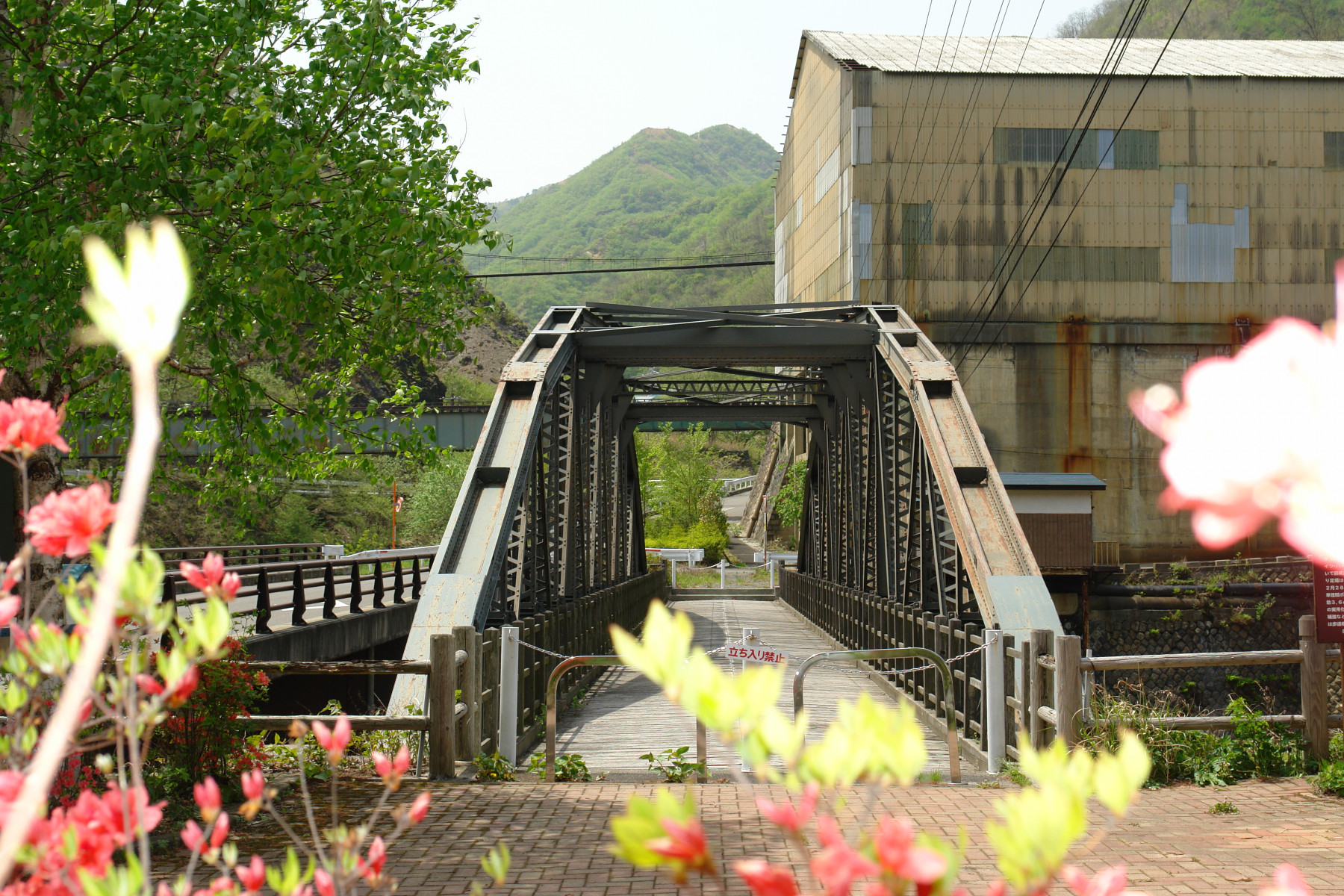産業遺産の見どころ
旧小滝支局木橋 OLD WOODEN BRIDGE OF KODAKI OFFICE 1888
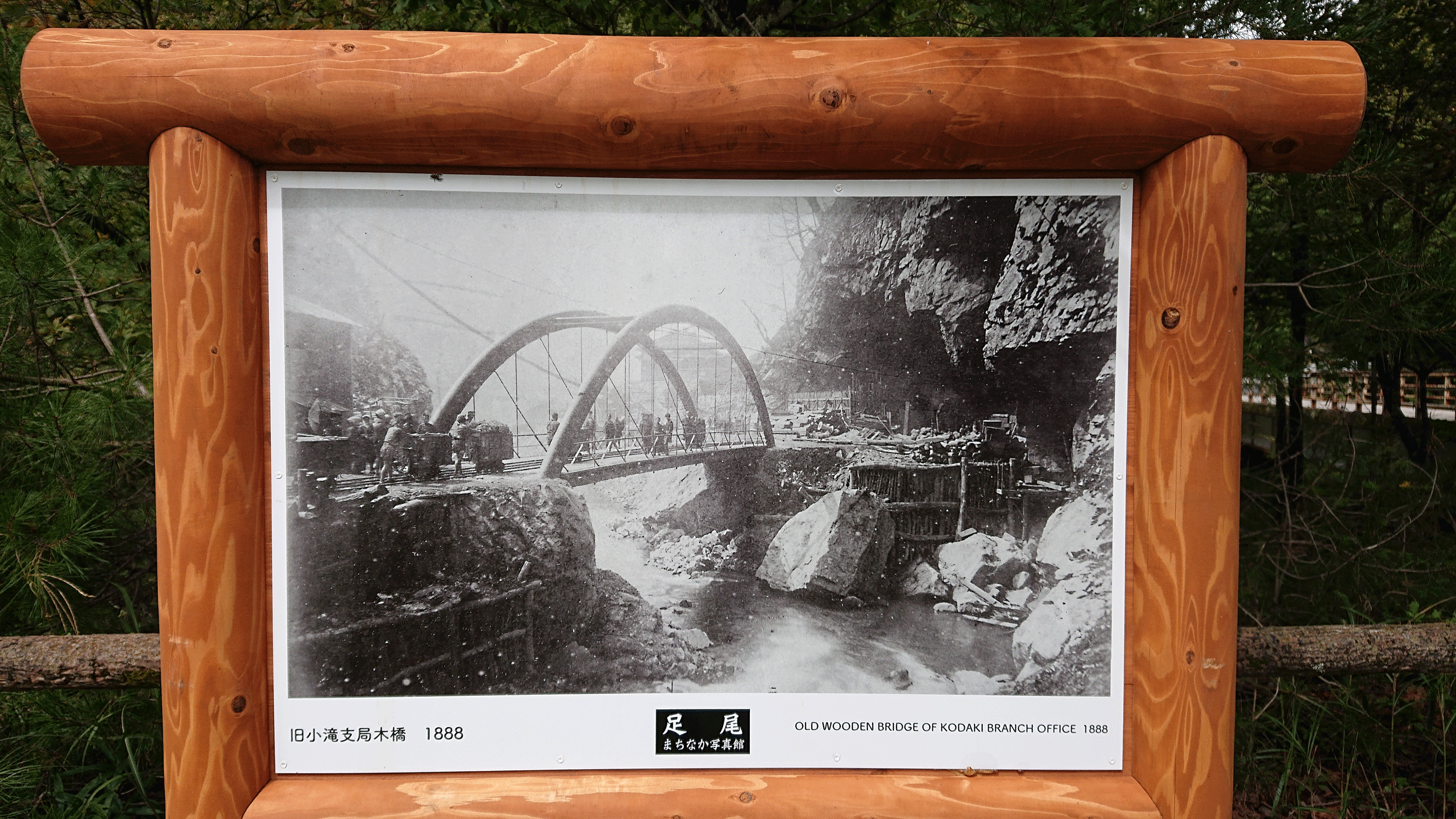
1886(明治19)年、分局を作り小滝開坑を開始しました。木橋は開坑に合わせ1887~1888年に完成し小滝局が開設されました。
木橋はアーチ状下路橋です。アーチ状下路橋の木橋は橋の産業遺産のオーソリティである伊東孝先生によれば日本でこれのみではないか?との見解を得ました。貴重な木橋でしたが、1888~1895年で役目を終えたと推察されます。
![]() 旧小滝支局木橋について.pdf (0.57MB)
旧小滝支局木橋について.pdf (0.57MB)
OLD WOODEN BRIDGE OF KODAKI OFFICE
In 1886, a branch office was created to commence Kodaki mineshaft project.
The construction of wooden bridge was completed between 1887 to 1888 in time of completion of mineshaft, when Kodaki office was also established. The bridge is arched and has a passage underneath. According to Dr.Takashi Ito, the authority of the industrial heritage of bridge, this is the only wooden arched bridge with underpass in Japan. Although the bridge was a valuable site, it finished serving its role in 1895.
南夜半沢社宅&北夜半沢社宅 MINAMIYAHANZAWA&KITAYAHANZAWA MINING COTAGES1918
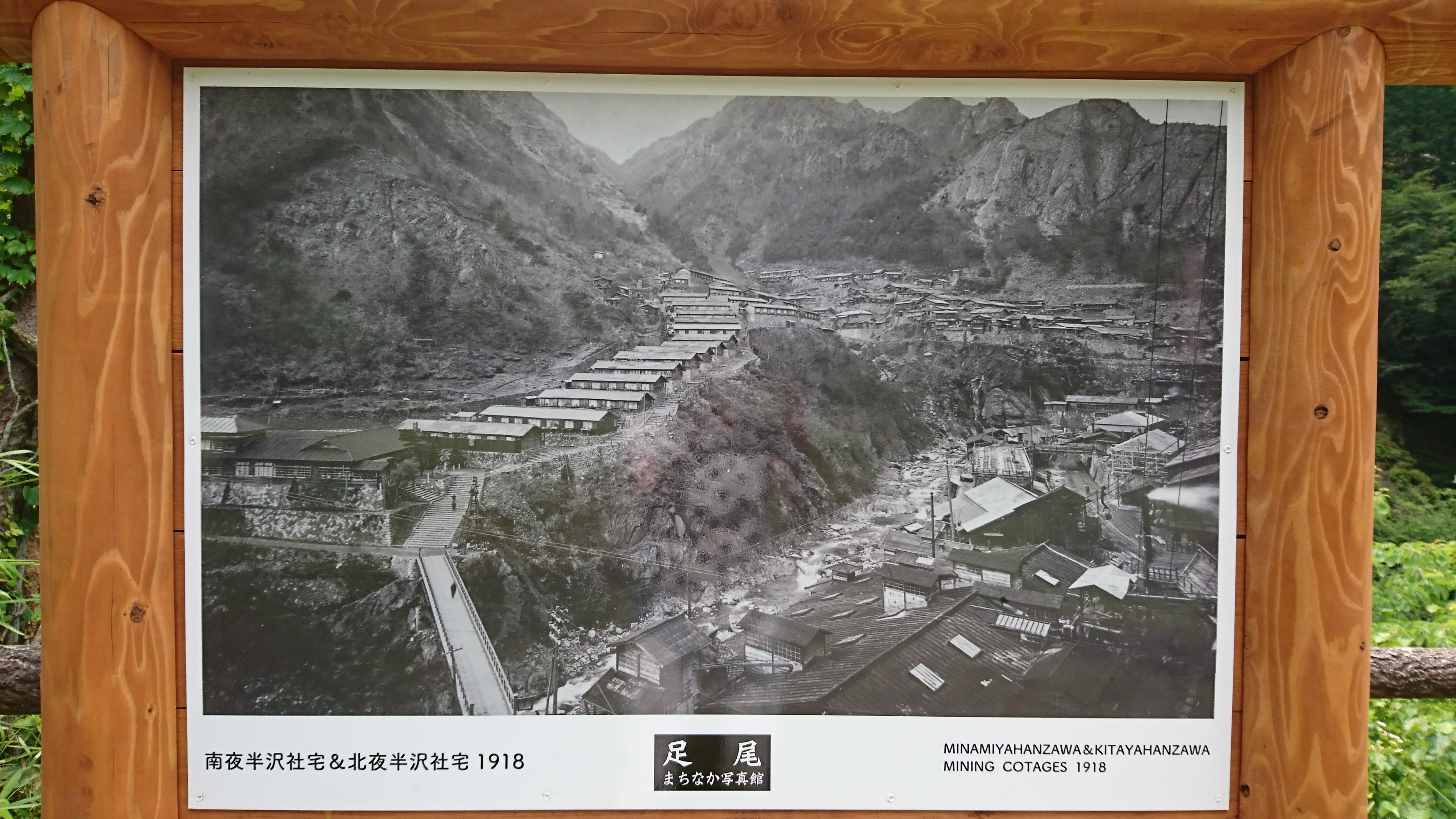
夜半沢は、庚申川右岸の夜半沢両岸に造られた鉱山集落で沢の左岸を北夜半沢、右岸を南夜半沢と呼んでいました。どちらも山の傾斜地を切り取って石垣で囲った階段状の住宅集落です。
南夜半沢には、平屋建て木造の小滝病院と二階建て木造の病室がありました。病院は銅山医局分院として明治22年11月に開設され、長い間、小滝地域の医療の中心的役割を果たしてきましたが、昭和28年10月、入院設備を廃止し機能も診療所に縮小、小滝撤収にともない全面廃止されました。
北夜半沢は、坂道がつづく鉱山住宅地で、裾野は職員、山手は鉱員の住宅になっていました。
MINAMIYAHANZAWA & KITAYAHANZAWA MINERS’ COTTAGES 1918
Yahanzawa is a mining village developed on the right side of Koshin River, the bank on the left side was called Kitayahanzawa and the one on the right side was called Minamiyahanzawa. Both are staircase-shaped residential settlements fenced with stone walls that were built on a cutout of the slope of a mountain.
Minamiyahanzawa had a single story Kodaki hospital and a two story patients’ room both made of wood. The hospital was opened as a branch of the Dozan Medical Office in November 1889, has played the primary role in the local medical field for a long time. However, in October 1953, the hospital abolished some of their facility and discontinued their service for inpatients, became a clinic in 1953. The hospital was fully shut down as Kodaki declined.
Kitayahanzawa was a miners’ residential area with continuous slopes cottage. The staff member lived in the foot of mountain and miners did in the upper part of the hill.
小滝選鉱所跡 OLD KODAKI DRESSING PLAMT1889~1920.3
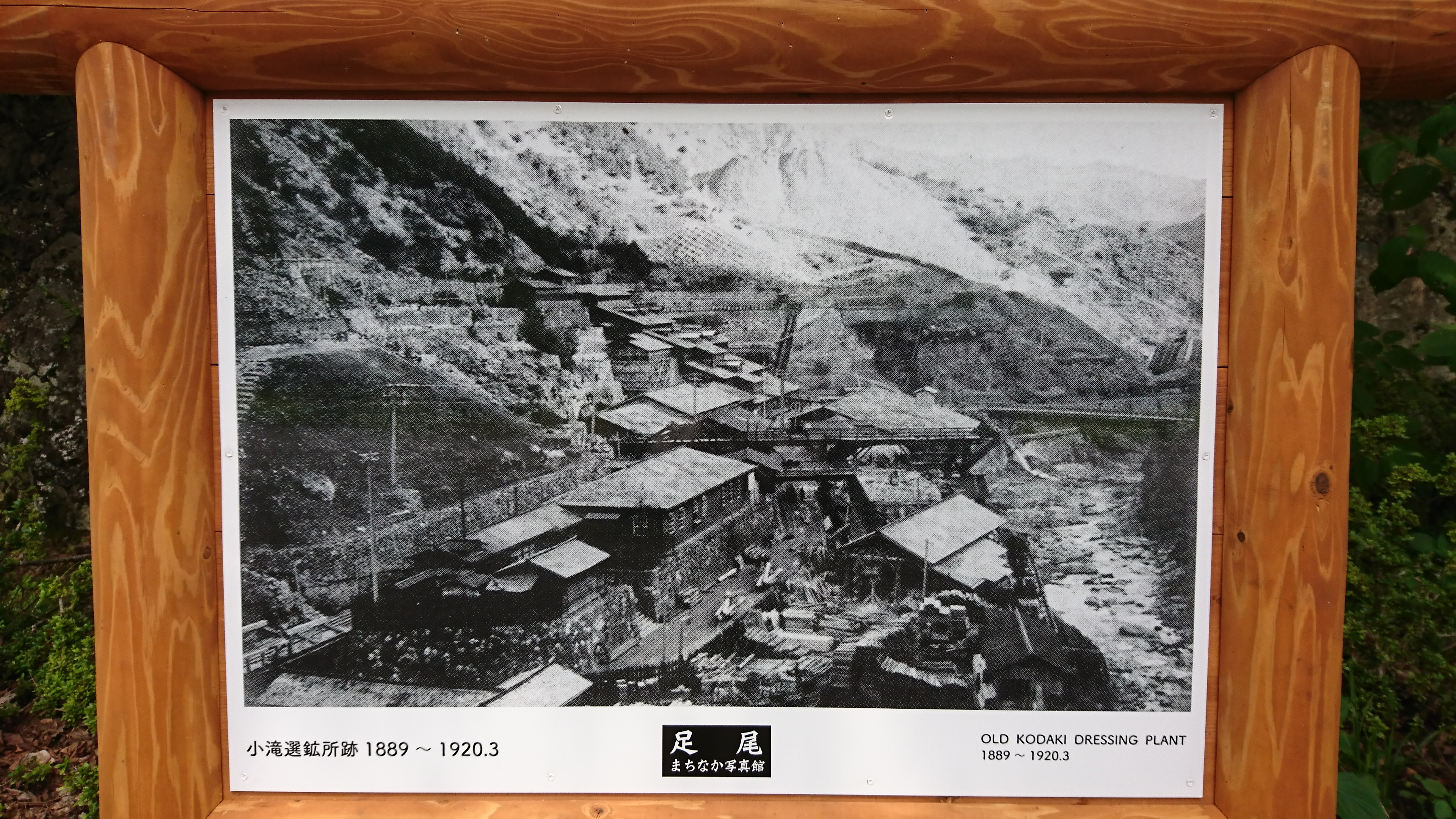
1886(明治19)年4月に小滝坑が開坑されると、下駄造り小屋が1軒あっただけの地域に庚申川に沿って路が開かれ、24年には馬車鉄道が敷かれ、26年1月には銅山私立小滝小学校が開校され賑わいをみせ人口が増えていきました。明治30年には鉱毒予防工事を受けて製錬所を閉鎖、大正9年にはここ選鉱所も廃止され、青葉の小滝を早い段階で取り戻すことになりました。盆踊りには、小滝通洞本山踊れ♬~やぐら備前で~中に立つ~、花の渡良瀬~♬青葉の小滝~♪月の眺めは備前楯~、応援歌には山晴れ~水澄む~われらが小滝~♪と小滝の存在は大いにあったようです。山手に選鉱所(煉瓦構築物が残っています)、選鉱所の手前は小滝事務所(昭和21年焼失)、川側に職員浴場、遺構の上階段右手に小滝座劇場(昭和21年焼失、昭和23年~29年小滝会館)など小滝の生産管理の拠点でした。
明治以降も小滝は発展し、大正年間には、新長屋、畑尾、爺々が沢、北夜半沢、南夜半沢、道路社宅、2号長屋、銀山平などの社宅が増設されました。小滝にはその遺構があちこちで見られます。文象の商店には、旅館(梅の屋)、料理屋(石川屋、松の屋)、芸者屋、酒屋(伊勢屋、中川)小滝座、雑貨屋(越前屋、山善)、呉服屋(相田、平瀬)、そば屋(二ツ木)、質屋、建具屋、郵便局などがあり、花柄には、料理屋(みますや)、芸者屋(谷の屋)、雑貨屋(大津屋)、材木薪炭、呉服屋などがあったようです。小滝の人口は、1万人を超すほどになりました。
FORMER KODAKI DRESSING PLANT 1889 ~ 1920.3
When Kodaki mineshaft opened in 1886, a road was paved along the Koshin River in the area where only had one Geta-structured warehouse. A horsecar railway was laid in 1891, and the Dozan private Kodaki Elementary School was established in January 1893. The population has increased, and the town started to flourish. The smelter was shut down due to the mine poisoning prevention installation in 1897, the dressing plant was abolished in 1920, resulting in the regain of the verdure in Kodaki a pit early stage. The presence of Kodaki can be recognized in the lyrics of the Bon Odori song (♪ “Kodaki Tsudo Honzan, we shall dance standing on a scaffold, the flowers of Watarase, the verdure of Kodaki, the moon of Bizentate”) and the cheering song (♪ “sunny day on a mountain, water is clear, that is our Kodaki”) Some of the old landmarks of production and management exists in Kodaki. The dressing plant (brick-made building remains) is on the hilly side, with Kodaki’s office (burnt down in 1946) being next to it. The bathing facility for the employees (burnt down in 1946) existed on the river side, and Kodakiza theatre (used as Kodaki community hall from 1948 to 1954) was on the right to the upper stairs in the remains.
Kodaki continued to develop after Meiji era, and numbers of miners’ cottages (Shin Nagaya, Hatao, Jijigasawa, Kita Yahanzawa, Minami Yahanzawa, Road Housing, Nagaya No. 2, Ginzandaira) were constructed during Taisho era. There were several stores in the shopping arcade of Bunzo, including a Japanese-style hotel (Umenoya), restaurants (Ishikawaya, Matsunoya), a Geisha theatre, liquor stores (Iseya, Nakagawa), Kodaki theatre, general stores (Echizenya and Yamazen), Kimono stores (Aida, Hirase), a Soba restaurant (Futatsugi), a pawn shop, a joinery store, and a post office. Whilst Hanagara had a restaurant (Mimasuya), a Geisha theatre (Taninoya), general store (Otsuya), a wood and coal dealer, and a Kimono store etc. The population of Kodaki has grown to over 10,000.
銀山平社宅跡 OLD GINZANDAIRA MINEAER'S COTAGE1912~1954
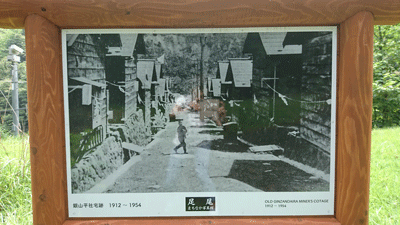
銀山平社宅は、現国民宿舎かじか荘と銀山平キャンプ場一帯にあった銅山製材所の作業員のための社宅として建てられました。
今でも石積みが残っています。銀山平は、銅山の中において銀が取れた地区で銀山坑口がありました。閉山直前に鉱業所所長の命で奈良部組が再度開削した際に、黄鉄鉱の大壁にぶち当たってしまいました。銀の採掘は少量だったためすぐに閉鎖されてしまったようですが、黄鉄鉱の壁は圧巻だったことでしょう。
OLD GINZANDAIRA MINERS’ COTTAGE 1912-1954
Ginzandaira miners’ cottage was built as a residency for miners working at Dozan lumbermill in the area where covers current Kajikasou and Ginzandaira camping site.
The stone masonry can be seen until today. Ginzandaira was renowned as a mining area of silver and had a silver mine shaft. When Narabu group re-excavated the area upon the chief mining director’s command before the mountain closed, they hit a big wall of iron pyrites. The mountain was closed shortly due to the limited amount of silver exploitation; however, the scale of the iron pyrites wall must have overwhelmed people.
銅山製材所跡 OLD SAWMILL FOR ASHIO COPPER MINE1905~1939
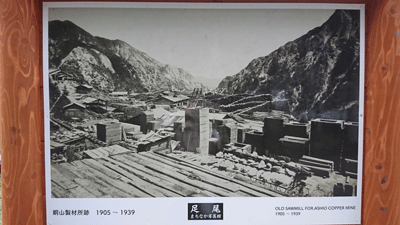
明治38年に開設した銅山の支柱のための製材所で、群馬県根利山で伐採された木材を受け入れるため約20キロの索道が開設されました。根利でも2000人規模の集落が出来、学校も開校されました。
1924(大正13)年当時の設備は、帯鋸1台、竪鋸1台、丸鋸2台、切端鋸1台を備え最盛期には5万尺〆の用材、23000尺〆の支柱材、40万枚の矢板を年間に使用したといわれ、それを一手に引き受ける最新製材工場で、ここを基点に索道で全山に用材を送り込みました。1939(昭和14)年森林資源の限界からその役目を終えました。続いて索道網も廃止されました。
この製材所は、当時東洋一製材所と謳われた規模でした。日本で最初に導入された電気のこぎりは、その威力を発揮したようです。
OLD SAWMILL FOR ASHIO COPPER MINE1905-1939
A sawmill for the bracing of a copper mine was opened in 1883, and a cableway of about 20km was built to transport the timber cut down at Mt. Neri in Gunma Prefecture. Being affected by the industry Neri has become a village of 2000 people and a school was established.
At the time of 1924 was the sawmill was equipped with one band saw, one light car, two round buildings, and one cutting edge building. 50,000 shaku (approximately 15151 meter) of lumber, 23000-shaku (approximately 6969 meter) of bracing, and 400,000 sheets of sheet pile was used annually at its peak. The sawmill had the most up-to-date facility at the time, and all the lumbers were sent from here to every area of the mountain using the cableway. In 1939, the facility finished serving its role due to the limit of nature resources, and the cableway network was also abolished subsequently. The scale of the sawmill was said to be the largest in the Orient at that time.
The electric saw that was first introduced here in Japan and demonstrated its power.
